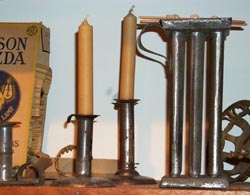|
Candlesticks
and Candle Molds
Though
electricity was appearing in many of the towns around the Skagit County
area in 1890, gas lanterns (kerosene) and gas lighting (acetylene
gas) were used in most of the homes into the first decade of 1900.
Candle lighting was a technology from an earlier time. It would have
been used in simple, homesteader's homes to enhance lighting or on
the table for company. Miners also used them.
Candles were made out of tallow, rendered beef, pork or bear fat.
Candles for company would have been made out of beeswax, which smelled
nice, burned slowly, and had little smoke. Tallow candles did not.
After the mid-1800's paraffin wax candles were also available. The
Sears Roebuck Catalogue of 1897 lists these candles at 11 cents per
pound, with 12 to a pound. It also sold Granite Wax Mining Candles,
6" inches long for 8.5 cents a box.
On
the shelf above are three candlesticks and a candle mold. They are
all made out of tin, but the candlesticks have levers to raise a candle
as it burned.
The 4 ½" candlestick on the far left has the traditional
finger hook at the bottom of the holder. The other two were called
push-up candlesticks. They have the finger hook at the top and a sharp
round base. This style of candlestick was often called a hog-scraper
as farmers would use the base to scrape the bristles from hogs at
butchering time. Edna Breazeale of Bayview owned these hog-scraper
candlesticks.
The candle mold was used for making poured candles. This one has 6
holes so it was called a 6-holer. Rods were placed on top from which
wicks were hung down and tied into each hole. Mrs. Mangus Anderson
and Mrs. Charles Tolbers, both early pioneers on the Skagit Delta,
used this mold.
|







